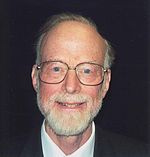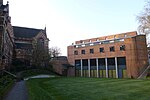Beecroft Building

The Beecroft Building is one of the buildings forming part of the Department of Physics, University of Oxford in Oxford, England.The Beecroft Building is immediately in front of the Lindemann Building and close to the Clarendon Laboratory Townsend Building. It is located on Parks Road in the Science Area of Oxford University. It is next to the University Parks, immediately to the north. The Beecroft Building was designed by Hawkins\Brown and completed in 2018. Planet Partitional was also involved with the contract. The budget was approximately £40 million.The building was opened by Sir Tim Berners-Lee (who studied Physics as an undergraduate at Oxford) on 17 September 2018, in the presence of Professor Louise Richardson (Vice-Chancellor of Oxford), Lord Patten of Barnes (Chancellor of Oxford), Professor John Wheater (Head of the Department of Physics) and Adrian Beecroft (part-funder of the building).The building is named after its part-funder Adrian Beecroft. The building is specifically focused on theoretical, condensed matter and quantum physics. According to The Daily Telegraph, the funding for this building was inspired by Beecroft's interest in astrophysics.
Excerpt from the Wikipedia article Beecroft Building (License: CC BY-SA 3.0, Authors, Images).Beecroft Building
Parks Road, Oxford City Centre
Geographical coordinates (GPS) Address Nearby Places Show on map
Geographical coordinates (GPS)
| Latitude | Longitude |
|---|---|
| N 51.7598151 ° | E -1.2577957 ° |
Address
Keble Triangle
Parks Road
OX1 3AQ Oxford, City Centre
England, United Kingdom
Open on Google Maps










